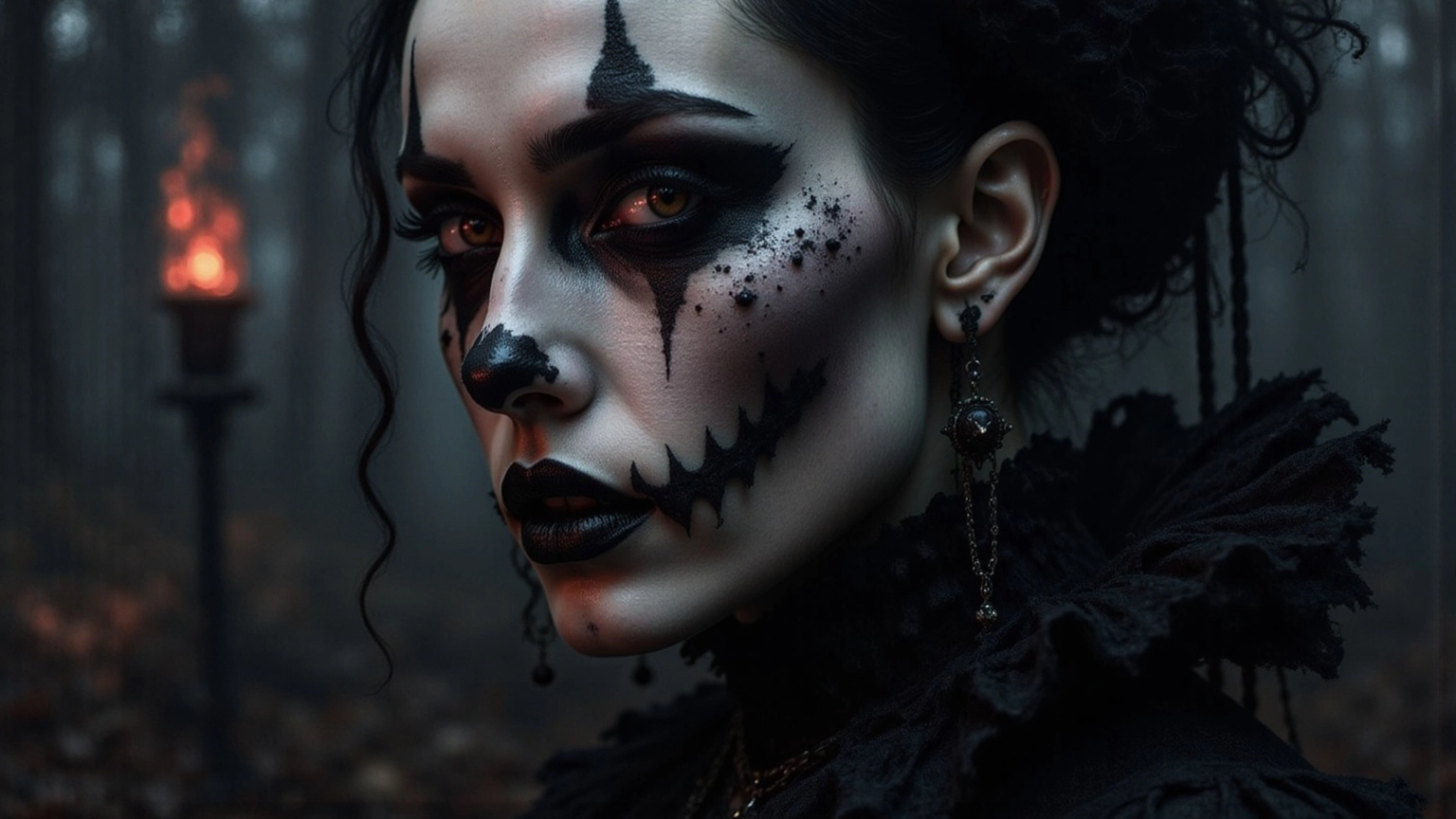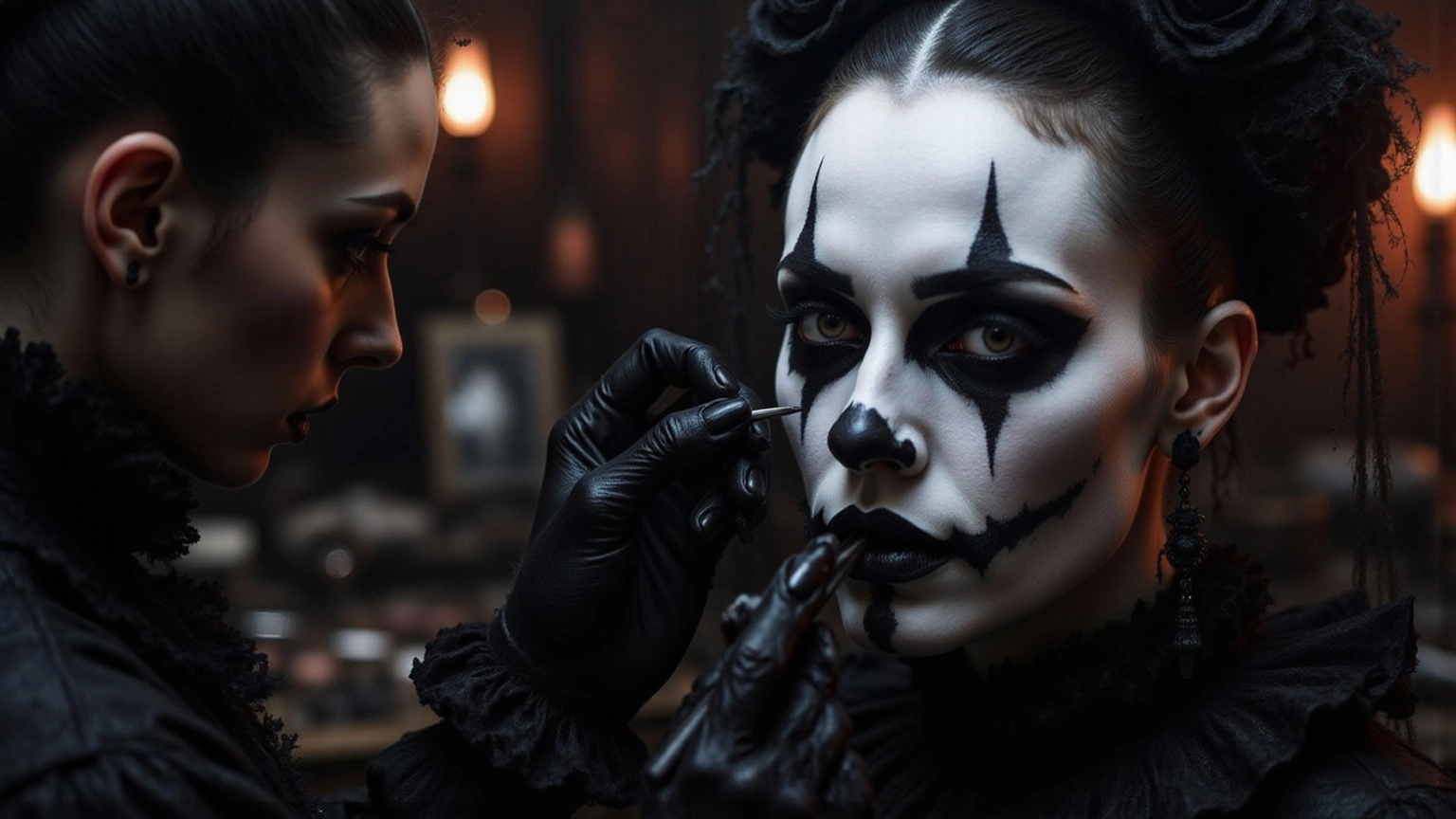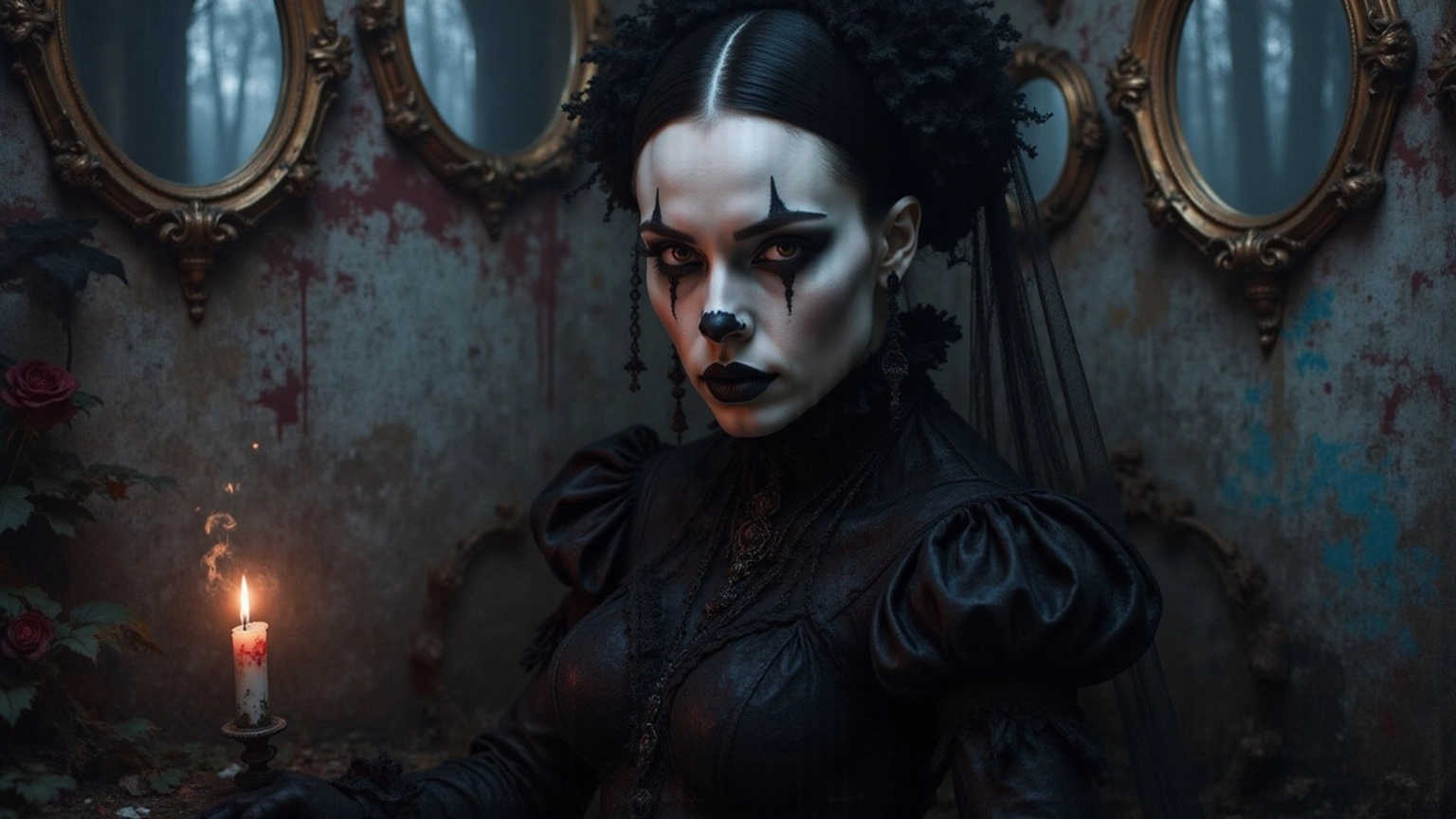
Understanding Goth Clown Makeup: Origins, Techniques, and Appeal
Share
Overview
Goth clown makeup—a striking blend of playful clown aesthetics and dark gothic flair. It’s not just makeup; it’s a daring declaration of individuality that flips traditional beauty standards on their head. This article unveils its evolution, showcasing key techniques and cultural significance. Here, creativity meets a broader narrative of identity and societal critique, especially in the age of social media, where beauty norms are constantly challenged.
What does it mean to wear this bold style? It’s a canvas for self-expression, a rebellion against the mundane. Each stroke of color tells a story, each shadow whispers secrets of the night. This makeup transcends mere appearance; it invites you to explore the deeper layers of identity and culture. Are you ready to dive into this gothic carnival of self-discovery?
Goth clown makeup isn’t just a trend; it’s a movement. It beckons those who dare to defy conventions, to embrace their inner darkness while celebrating the playful spirit of the clown. It’s a call to action—join the ranks of those who wear their art unapologetically, who challenge the status quo with every bold brushstroke.
In a world obsessed with perfection, goth clown makeup stands as a beacon of authenticity. It’s a reminder that beauty is multifaceted and that true expression lies in the courage to be different. So, what’s stopping you? Step into the shadows, paint your face, and let your true colors shine.
Introduction
In a realm where self-expression rules, the striking fusion of goth and clown aesthetics rises as a mesmerizing trend, daring enthusiasts to plunge into the whimsical yet profound depths of identity and emotion.
Goth clown makeup—its stark white face paint and bold black accents—transcends mere visual allure, acting as a fierce critique of societal norms and the duality woven into the human experience.
As Halloween looms and curiosity for unique makeup styles ignites, this audacious look resonates with those yearning to intertwine whimsy with darkness, echoing a richer cultural narrative that champions individuality.
With social media's grip amplifying its presence, the goth clown aesthetic is no fleeting fancy; it embodies a vibrant tapestry of artistic expression that continues to morph and inspire.
Defining Goth Clown Makeup: An Overview
Goth clown makeup isn’t just a style; it’s a bold statement. This unique look fuses the playful, exaggerated flair of traditional performer face decoration with the dark, dramatic essence of gothic design, creating a style reminiscent of goth clown makeup. Picture stark white paint splashed across the face, bold black accents framing the eyes, and exaggerated mouth shapes—tears and cracks weaving a tale of melancholy and eeriness. It’s a visual feast that beckons those who revel in the whimsical and the macabre.
As Halloween beauty trends surge, inquiries have spiked by 80%. The gothic jester style, characterized by goth clown makeup, rises to the occasion, reflecting a growing fascination with blending playful elements and somber motifs. Case studies reveal a surge in ethereal and 3D Halloween face art, seamlessly intertwining with dark jester styles. These complex designs captivate those eager to amplify their Halloween expressions with goth clown makeup. Experts assert that the dark jester aesthetic transcends mere trendiness; it’s a profound exploration of the duality of human experience—where joy dances with sorrow. Nostalgic themes from film and television resurface, and the goth jester aesthetic emerges as a potent expression of individuality and creativity. It invites enthusiasts to delve into the depths of their artistic expression. Brands like Darc Arts echo this sentiment, blending elegance with darker themes, crafting spaces for personal narratives and emotional exploration.
Historical Context and Evolution of Goth Clown Makeup
Jester makeup? It’s a wild tapestry woven from ancient customs where jesters weren’t just clowns—they were the sharp-tongued mirrors of society. Fast forward to the 19th century, and you’ve got the contemporary performer strutting in whiteface and Auguste styles, flaunting exaggerated features and vibrant colors that scream for attention.
But wait—enter the late 1970s. A darker subculture rises, dripping with themes pulled from the depths of music, literature, and art. This isn’t just a style; it’s a rebellion. The collision of styles in goth clown makeup begins to throb in the early 2000s, especially within alternative fashion circles. Here, individuals aren’t just dressing up; they’re crafting identities that blend humor with shadows, showcasing their creativity through goth clown makeup, a daring statement in a world that craves authenticity.
Are you ready to dive into this fusion of light and dark, where every brush stroke tells a story? The jester’s face isn’t just paint; it’s a canvas of expression, a portal into a culture that refuses to be boxed in. Explore the depths of this aesthetic, where laughter meets the eerie whisper of the unknown.

Key Techniques and Characteristics of Goth Clown Makeup
Essential methods in dark comedic face painting? They’re all about crafting a striking visual impact through razor-sharp application and wild creativity. Start with a smooth white base—your flawless canvas—achieved with top-tier face paint or cream foundations. Artists go bold, accentuating the eyes with heavy black eyeliner and shadow, creating a dramatic contrast that pulls you in. The mouth? Exaggerated with daring colors, and don’t shy away from fake blood or tears to ramp up the emotional intensity.
Want to add depth and character? Sprinkle in beauty marks or cracks, weaving a richer narrative into your look. Mastering blending and layering techniques is non-negotiable; it opens the door to a spectrum of expressions, from whimsical to haunting. This intricate method shines a spotlight on creativity, inviting you into a world where every brushstroke tells a story, embodying the unique allure of alternative aesthetics.
But don’t just take my word for it. A renowned cosmetics artist once whispered, "The allure of dark theatrical face paint resides in its capacity to elicit feelings through pronounced characteristics and vivid hues." Brands like Mehron and Snazaroo? They’re the go-tos for achieving those jaw-dropping effects in dark-themed performances. And here’s a kicker: 70% of beauty artists swear by cream foundations for their versatility and coverage—absolute staples in this style.
Now, let’s discuss goth clown makeup. It’s not just art; it’s a lifestyle story, echoing the ethos of brands like Darc Arts, which beckons you to embrace the unknown. This connection underscores the broader theme of gothic beauty, especially as it relates to goth clown makeup, where every cosmetic technique weaves into a larger narrative of elegance and intrigue. Ready to dive deeper into this captivating world?

Aesthetic Appeal and Cultural Significance of Goth Clown Makeup
Goth clown makeup defies the mundane, weaving a visual tapestry that celebrates individuality and personal expression. This audacious style of goth clown makeup speaks volumes to those on the fringes, offering a whimsical yet profound exploration of the shadowy corners of identity. By juxtaposing joy and sorrow, the use of goth clown makeup serves as a bold critique of societal beauty standards, inviting wearers to delve into their own narratives. In the age of social media, platforms like TikTok and Instagram have catapulted this aesthetic into the spotlight. A kaleidoscope of creative interpretations and tutorials thrives here, nurturing a vibrant community that revels in both gothic allure and playful whimsy. This digital realm doesn't just showcase the striking beauty of goth clown makeup; it ignites a dialogue about alternative beauty norms, championing inclusivity and diversity in self-expression.
As the cultural landscape evolves, the significance of goth clown makeup remains undeniable. It shatters conventional notions of beauty, beckoning individuals to redefine allure on their own terms, including the use of goth clown makeup. This choice resonates deeply with those eager to express their true selves using goth clown makeup. A study reveals an effect size of 1.67 for male images, highlighting a substantial shift in perceptions of beauty standards. Moreover, the case study 'Diversity in Body Composition Research Participants' sheds light on how various demographics interpret body attractiveness, enriching the conversation around alternative beauty ideals. Sophie Humphrey points out that the 2000s saw a surge in eating disorders among women, fueled by an oppressive diet culture—a stark reminder of the need to reshape our understanding of beauty. As beauty and fashion norms continue to shift, hope glimmers for greater inclusivity and visual appeal on the horizon.

Contemporary Trends and Influences in Goth Clown Makeup
Dark circus aesthetics are not just a trend; they’re a rebellion, sculpted by the rise of alternative fashion movements and an unapologetic embrace of diverse identities. Social media’s content creators and beauty professionals are the new alchemists, spinning the jester-inspired look into a tapestry of clowncore and emo vibes.
Halloween and themed parties? They’re the playgrounds for the bold, where creativity takes center stage, and the dialogue around mental health transforms style into a potent narrative. Mariana O’Connor hits the nail on the head: 'Both in marketing and in life, we can take this important lesson into consideration.'
Self-expression is the pulse that shapes our identities. A staggering 60% surge in costume inquiries reveals the allure of dark jester face paint—this isn’t just a trend; it’s an evolution. As beauty boundaries dissolve, goth clown makeup emerges as a vibrant canvas, inviting everyone to dive deep and redefine their identities.
Conclusion
Goth clown makeup isn’t just a trend; it’s a striking collision of whimsy and darkness, a daring form of self-expression that challenges the mundane. With its stark white face paint and bold black accents, this aesthetic dares you to confront the complexities of identity and emotion. As Halloween creeps closer, the surge of interest in unique makeup styles only amplifies the allure of goth clown aesthetics, weaving playful yet profound narratives.
This art form, steeped in the traditions of clowning and gothic subculture, has morphed into a vibrant artistic statement. The meticulous application and storytelling techniques allow artists to unleash a spectrum of emotions, captivating audiences and enriching the narrative. It’s not just makeup; it’s an intricate dance of charm and darkness.
Platforms like TikTok and Instagram have ignited a cultural revolution around goth clown makeup, crafting a community that embraces alternative beauty standards. Within this digital realm, inclusivity reigns, empowering individuals to redefine attractiveness on their own daring terms.
Ultimately, goth clown makeup transcends mere trend status; it’s a rich tapestry of artistic expression that resonates with contemporary themes of individuality and emotional exploration. As more souls embrace this unique fusion, they weave a narrative that champions creativity and defies conventional beauty norms. The goth clown aesthetic is not just a fleeting moment; it’s a movement that will continue to inspire and evolve, beckoning you to delve deeper into its enchanting allure.
Frequently Asked Questions
What is goth clown makeup?
Goth clown makeup is a unique style that combines the playful, exaggerated features of traditional clown makeup with the dark, dramatic elements of gothic design. It features stark white paint on the face, bold black accents around the eyes, and exaggerated mouth shapes that convey a sense of melancholy and eeriness.
Why has interest in goth clown makeup increased recently?
Interest in goth clown makeup has surged by 80% due to rising Halloween beauty trends. This style reflects a fascination with blending playful elements and somber motifs, which has captivated those looking to enhance their Halloween expressions.
What themes are associated with the gothic jester style?
The gothic jester style explores the duality of human experience, merging joy with sorrow. It often incorporates nostalgic themes from film and television and serves as a powerful expression of individuality and creativity.
How does goth clown makeup relate to personal expression?
Goth clown makeup invites enthusiasts to delve into their artistic expression, allowing them to craft identities that blend humor with darker themes. It serves as a canvas for personal narratives and emotional exploration.
What historical influences are present in jester makeup?
Jester makeup has roots in ancient customs where jesters acted as sharp-tongued mirrors of society. In the 19th century, contemporary performers adopted whiteface and Auguste styles, characterized by exaggerated features and vibrant colors. The darker subculture of the late 1970s further influenced the evolution of goth clown makeup.
How has goth clown makeup evolved over time?
Goth clown makeup began to emerge in the early 2000s within alternative fashion circles, where individuals used it as a way to create identities that combine humor and shadows, reflecting a desire for authenticity in their expressions.
